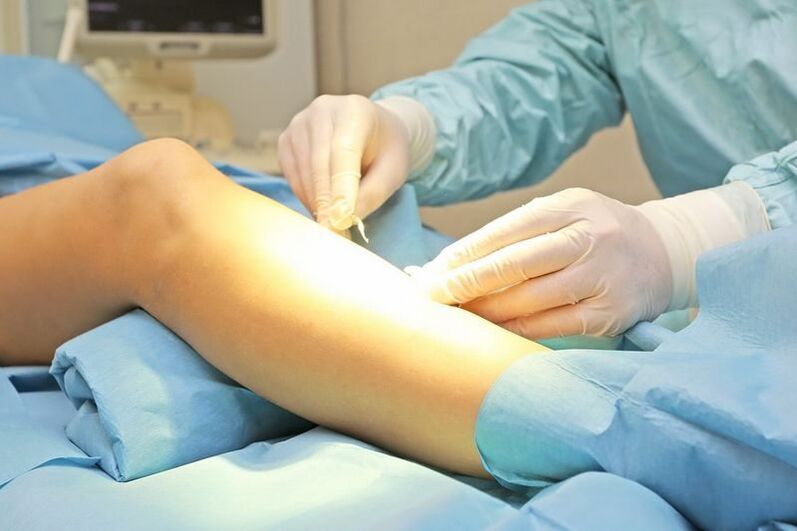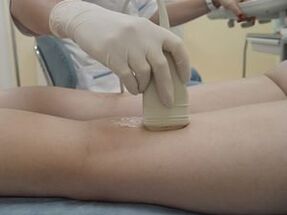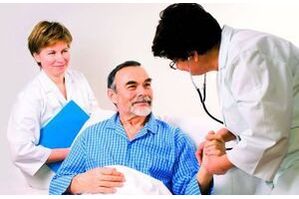
Removal of the veins in the lower extremities is called radical treatment. Surgery to remove varicose veins in the legs may be prescribed for patients if there is no adequate therapeutic effect using conservative and alternative treatments and the disease continues to progress.
With advanced forms of varicose veins, surgery can address the following:
- Eliminates pathological reflux (regurgitation) of blood.
- A disease-free, healthy portion of the great saphenous vein is preserved.
- Eliminate the affected area of the vein.
Before surgery, your doctor will mark the vein under ultrasound control so you can determine the extent of the affected part. Affected blood vessels and portions of veins are removed using a narrow probe inserted through a small incision. After the affected area is removed, the risk of disease recurrence is low.
After surgical removal of varicose veins, the chance of disease recurrence is low.
In modern medicine, they prefer combined phlebotomy, which involves the use of multiple techniques at once.
The main stages of combined radical treatment are: upper and lower transection, short stripping, perforator vein ligation, and venule resection.
During the initial stages of disease, any of the procedures listed can be used as a stand-alone operation. In some cases, minimally invasive treatments in the form of sclerotherapy or laser occlusion may be offered as an alternative to some stages of classic combined phlebotomy.
Operation type

The common name for surgery to remove an affected vein is phlebectomy. Modern types of this program:
- The stripping procedure (long or short) is performed as the gentlest technique, during which the doctor can only remove a specific part of the affected vein. The procedure is done through a small incision along the vein.
- The implementation of laser phlebotomy is a modern treatment method that involves the use of lasers. Thanks to this tool, the laser coagulation process takes place inside the affected blood vessels. The procedure is performed under local anesthesia and does not require the use of special surgical instruments. The laser is injected into the vein with a small diameter catheter, and then under the influence of the pulse, small bubbles are formed that affect the vessel wall. As a result, the affected vein becomes part of the tissue and no longer bothers the patient.
- The affected vein is resected endoscopically. In this case, an endoscope is inserted into the venous area, and the doctor can personally analyze its condition and the degree of damage. In the future, surgeons will have the opportunity to remove the affected area.
The so-called seamless technique is very popular, when the affected area of the vein is removed through a small needle tip incision. The patient can walk independently 4-6 hours after the procedure. Endoscopic equipment is used if the development of nutritional disorders is observed.
Advantages of venule resection

Veneectomy is one of the most painless and non-invasive methods of surgically removing affected veins. The procedure is performed in three stages: diagnosis, where a small incision is made with a scalpel in the area of impaired blood flow, and the affected area of the vein is extracted.
The surgery is performed under local anesthesia, and the recovery period does not require much time for the patient. The puncture site does not form scars, bruises, and pain in individual cases.
Veneectomy is an almost painless way to remove varicose veins with a short recovery period after surgery.
To minimize the risk of bruising and bruising, surgery may be performed using tumescent anesthesia, which, in addition to the anesthetic, includes a substance that has vasoconstrictor properties. After surgery, the patient was discharged a few hours later without the toxic characteristics of general anesthesia and without pain.
transection
The concept of "cross resection" refers to the ligation and subsequent passage of the small or great saphenous vein. As a stand-alone procedure, this procedure should only be performed in emergency situations, when there is a risk of spreading acute thrombosis.
To date, there are more gentle alternative procedures to cross resection - performing endovascular laser ablation and radiofrequency ablation.
The advantages of these techniques are: general anesthesia can be refused, outpatient treatment, no cosmetic defects in the form of incisions and scars.
Among these disadvantages, one can note a higher probability of disease recurrence and the rather high cost of these procedures.
train

Surgery for varicose veins of the lower extremities is performed after an initial examination of the patient and an internal examination.
The following types of exams can be assigned:
- Ultrasound of leg veins.
- General blood analysis.
In the future, physicians will conduct an oral investigation to identify possible contraindications to surgical intervention. A preliminary examination allows you to choose the best type of surgical procedure, or, if necessary, combine several well-known methods at once.
It is important for patients to understand how to behave correctly before and after surgery. Before surgery, it is recommended not to take medications including acetylsalicylic acid because of the risk of bleeding. On the day of the surgery, there is no need to prepare the surgery very carefully - you just need to remove the hair from the area of the extremity being operated on.

When is surgery required?
Patients wondering if surgery is needed for varicose veins of the lower extremities should understand that this aggressive approach to treatment is needed in the following situations:
- The disease progresses rapidly and is accompanied by severe pain.
- Development of varicose thrombophlebitis of grades 1-4.
- A strong heat and burning sensation is felt in the venous area.
- Varicose veins spread above the kneecap.
- Swollen, unsightly vein formation may be seen.
This surgery is also indicated for the formation of long-term non-healing nutritional diseases (ulcers) for which conservative treatment has not been adequately therapeutic.
Contraindications and possible consequences

Possible contraindications and consequences of surgical intervention must be considered.
If the patient has a history of hypertension, arrhythmia, coronary heart disease, acute phase infectious disease, inflammatory disease of the leg skin, etc. , surgical intervention cannot be performed.
The third trimester of pregnancy and elderly patients with weakened immune systems are not suitable for surgery.
Patients should consider possible complications, as well as the consequences of surgical intervention:
- Sensitivity of the surgical limb is violated due to damaged nerve endings.
- Intermittent or persistent numbness in the ankle area.
- formation of pus.
- Development of bleeding of different intensities.
- Re-educate swollen veins above or below the postoperative scar.
- Pain syndrome does not afflict all patients and occurs if nerve endings are affected. In most cases, normalization of sensitivity occurs independently without the use of any drugs.
- Hematomas and bruising at the surgical site can be disturbing. In this case, drugs of the anticoagulant group for topical use can be prescribed. If the patient's skin is very delicate and sensitive, the traces of bruising can last for 1-1. 5 months.
- The development of edema may indicate that the patient is not following the doctor's instructions, not adhering to the rest regime and exposing the body, including the lower extremities, to excessive physical exertion.
Strictly follow your doctor's advice, depending on how quickly the consequences of the surgery will pass.
Therefore, before deciding whether surgery for varicose veins is worthwhile, you should consider all possible risk factors: thoroughly weigh the pros and cons. Surgery should be performed in cases where disease manifestations have long plagued the patient and significantly deteriorated quality of life.
It is also necessary to consult only experienced and qualified physicians who perform such procedures: phlebologists, vascular surgeons.
recovery period

After surgery, patients are advised to follow all instructions of the attending physician, shorten the recovery period as much as possible, and return to normal life as soon as possible. During the first 48 hours, patients are strictly prohibited from:
- Use of alcoholic beverages.
- Motor transport management.
- Bathe in the hot tub.
- Excessive physical activity.
In the first few days after surgery, there may be complaints of leg pain and increased body temperature. In this case, where medical treatment methods are involved, physical therapy is prescribed. The patient should not always be in a horizontal position. You should walk a little every day to restore blood flow.

In the future, the implementation of the following recommendations may also minimize the risk of developing these postoperative complications.
- Hydrotherapy, massage, therapeutic exercises and other physical therapy methods, prescribed by the attending physician. Such procedures prevent the formation of blood clots and normalize blood flow.
- During the first few months, both legs need to be rewound with special elastic underwear or compression stockings.
- Use of drugs in the group of intravenous injections, vasoprotectants. As the inflammatory process develops, antibacterial drugs can be prescribed. Pain relievers are used to relieve pain.
- If sutures have been applied, they can be removed 7 days after surgery.
- If the patient is overweight, it should be normalized to reduce venous load.
- It is recommended to prefer loose clothing and comfortable shoes made of natural fabrics. Wearing high heels is taboo.
- At home, you should try using rollers or pillows to elevate your legs.
The recovery period can be up to several weeks, during which the patient will receive special sick leave.
Modern methods of removing varicose veins only require a few days of recovery, but they are more expensive than usual.
In the future, the patient will have to come for a second exam and receive additional tests so that doctors can assess the effectiveness of the treatment.
operating cost
Phlebectomy is performed in public clinics and plastic surgery centers with the aim of eliminating aesthetic defects.
The patient is interested in the cost of varicose vein surgery.
It all depends on the qualifications of the clinic and the doctor performing the surgery, as well as the degree of progression of the disease and the complexity of the proposed surgery. The city and region where the patient intends to have surgery is not the last location where the price is formed.
Considering the cost, some clinics include a preoperative examination and a recovery period.
Expert prediction

The implementation of combined phlebotomy does not exclude the possibility of disease recurrence. After the use of radical treatment methods, due to the physiological characteristics of the body (the structure of blood vessels and veins) or a violation of the technique of performing the procedure (if the doctor cannot normalize the patency of the affected veins). The risk of further disease progression is observed in approximately 15-20% of cases. Patients should consult their doctor as soon as possible if they notice repeated manifestations of the disease.
Only an experienced specialist can help you properly recommend which surgery to choose to remove varicose veins and provide helpful advice to follow during recovery. The consequences can be the most tragic and irreversible if medical attention is not promptly given.


















